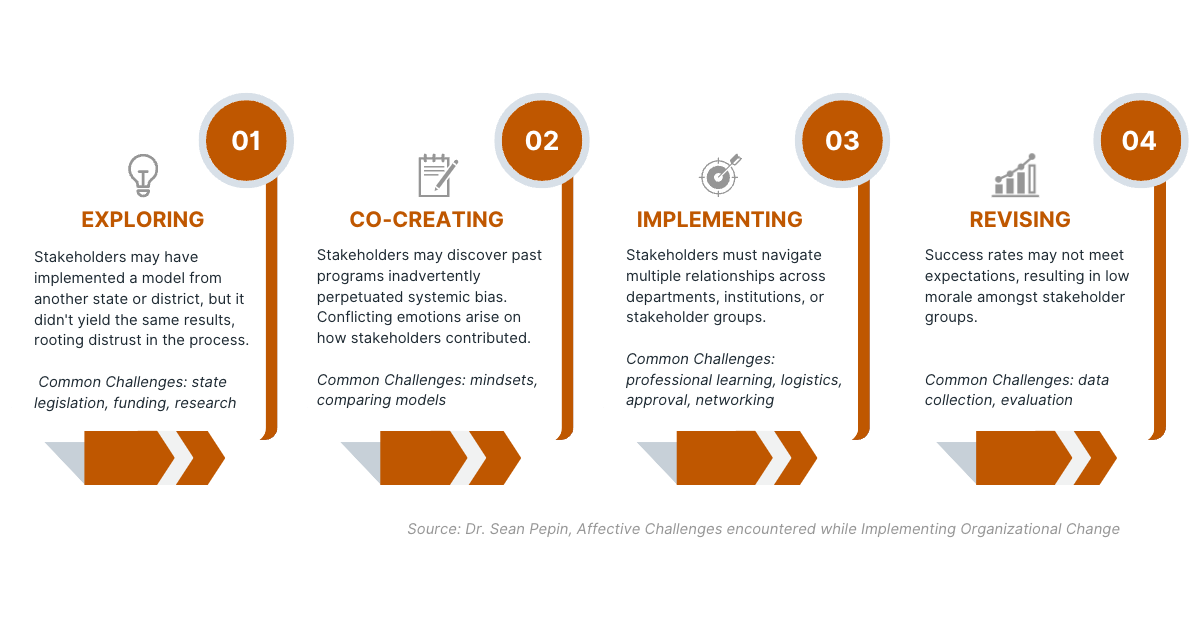
Closing the Gap: Recent Findings on Scaling Corequisites
Corequisite Resources
Designing and implementing corequisite courses can be challenging, especially since cross-functional groups at state, system, and institutional levels must work together to scale successfully. The following resources offer in-depth advice based on current research and best practices from industry experts.
The Challenges of Scaling Gateway Mathematics Corequisites
This report by Dr. Sean Pepin explores the development of corequisite courses across four states with commentary from over 20 leaders, faculty, and staff. Findings include common challenges, enabling conditions, stages of development, and five recommendations to assist stakeholders in implementing and scaling corequisites.
Key Stages of the Implementation Process:
- Assessing: Identify and assess enabling conditions.
- Exploring: Review research, guidance, and data.
- Cocreating: Convene and engage cross-functional teams.
- Implementing: Provide continuous professional development.
- Revising: Develop sustained and emotionally intelligent dialogues.
Corequisite Research Design Collaborative (CRDC) 2022 Convening Proceedings
Bruce Vandal’s report summarizes key discussions during the summer convening of Corequisite Research Design Collaborative (CRDC) members and higher ed reform leaders. Participants identified next steps for the field, using Dr. Pepin’s report as a framework, to support effective corequisite design and implementation.
Key Areas of Discussion:
- Deep dive into Dr. Pepin’s research from a faculty perspective
- Key themes for scaling corequisites
- Actionable next steps for future iterations
Why Developmental Courses Need an Upgrade
For decades, students were required to take, pass, and pay for a string of prerequisite or remedial courses. These remedial courses did not accrue credit towards their degree program, discouraging thousands of students from persisting in higher education. Corequisite models allow students to enroll directly into their gateway math course with additional support.
When corequisites were introduced as an alternative to long sequences of remedial courses, many institutions struggled to design and implement corequisite courses that met the needs of their students. Researchers, policy leaders, and advisors joined CRDC to support institutions in developing a better approach to corequisites with research-based practices.
“It’s just astonishing how much better the success is with corequisites than with the long train [of developmental courses]. I think that was what eventually changed the minds of the people [who] were the hardest to convince.”
- Math coordinator
To ensure corequisite models achieve more equitable outcomes, key stakeholders must build equity into the infrastructure from the outset. It’s important to identify existing barriers, enabling conditions, and effective capacity-building practices to support students holistically.
Common Challenges

Systems Level
When swift policy changes were deployed without sufficient guidance, as was frequently the case with corequisites, institutions were left to rely on their own resources. In some cases, mandates required complete removal of remedial courses without providing guidance on alternative paths like corequisite course models, according to Dr. Pepin’s research.
An additional challenge in some cases was that faculty and administrators were unaware that with the corequisite model, a course success rates may decrease while cohort throughput and success in a gateway math course increased. Dr. Pepin found that faculty skepticism, low morale, and distrust about corequisites were often due to this significant dip in course success rates.
“I’ve always felt very comfortable with my success rates and I always felt good about my teaching and the students’ learning. And everything just dramatically declined for the last few years…It’s hard to see…If you’re a teacher who cares and you want to see your students succeed, it’s very discouraging.”
- Math faculty, skeptical of corequisites
Other Challenges at the Systems Level:
- COVID-19’s impact on implementation efforts
- Transferring key research and data to key stakeholders
- Mismanaging logistics for scaling corequisites
- Policy shifts deployed all at once
Institution Level
When corequisites were implemented without clearly defined leadership within a system or institution, stakeholders reported difficulty working together and promoting buy-in among their colleagues. When administrators did not have the necessary tools and resources to scale implementation, issues such as misinformation from campus advisors, lack of professional development, and delays in curriculum approval impacted students.
Other Challenges at the Institution Level:
- Limited resources at small and rural colleges
- Choosing from (4) support model strategies
- Inconsistencies with placement procedures
- Navigating cross-functional teams
Best Practices for Scaling Corequisites
Although there are many challenges when implementing a new course framework like corequisites, Dr. Pepin identified best practices for each stage of the process. The five recommendations outlined below were based on feedback from system leaders for each stage of implementation.
Identify and Assess Enabling Conditions
Having a deep understanding of an institution’s landscape can help key stakeholders design a process that leverages existing strengths and enabling conditions. Conducting an internal audit, bringing together faculty, staff, and administrators as thought partners, and earmarking funds, can allow stakeholders to reinforce implementation from predetermined obstacles.
Provide Research, Guidance, And Data
Institutions are better equipped to launch a new program and communicate buy-in when clear research, guidance, and metrics are widely available to key stakeholders. Using both local and national research can build trust, prepare individuals, and provide insights on tried-and-true methods, contextualizing the process.
Engage Cross-Functional Teams
Teamwork is essential and when faculty, staff, advisors, and coordinators are included in the redesign, leaders can disperse the workload in more equitable and inclusive ways. Course development and implementation are most effective when responsibilities are shared, fostering awareness, understanding, and even champions of the work.
Provide Continuous Professional Development
Policy and practice changes are major shifts that can create ripples of fear, uncertainty, and excitement. With statewide professional development, instructors and campus professionals can discuss emotional responses, concerns, and questions with colleagues in the same boat. Scaffolded conversations that contextualize data and provide meaning can engage individuals in a shared understanding of the purpose behind corequisites.
Develop Sustained and Emotionally Intelligent Dialogues
After implementation is complete and students are impacted by the change, key stakeholders must grapple with both positive and negative results. Maintaining open lines of communication, transparent data, and critical feedback for continuous improvement is essential in upholding a sense of shared commitment to the cause.
Next Steps to Maximize Impact

Using the Dana Center’s corequisite resources can greatly inform systems and institutions at any stage of the process on best practices for corequisites. During CRDC’s 2022 convening, participants outlined key factors to keep in mind at all stages and all levels of corequisite implementation:
- Equity-Minded: Current and future reforms are designed to achieve equitable outcomes for Black, Latino, and Indigenous students, and students experiencing poverty, as well as other minoritized students using gateway math supports.
- Student Engagement: Students are the greatest stakeholders and should be front and center of the implementation process. Students who know how to access academic and non-academic resources are more likely to succeed.
- Data-Driven: Data allow key stakeholders to understand the effectiveness of past and future iterations with research-based strategies. Data are transparent and shared, and act as the backbone of any changes.
- Capacity Building: Key stakeholders have access to evidence-based professional development and opportunities for continuous improvement.
While corequisite course models are a work in progress, using the latest and most comprehensive information can equip stakeholders with the tools and resources they need to succeed. To learn more about corequisites, visit the Corequisite Research Design Collaborative (CRDC) for free resources and toolkits.
Get in Touch
How can the Dana Center work with you to ensure that our nation's students are ready for postsecondary education and the contemporary workforce?
